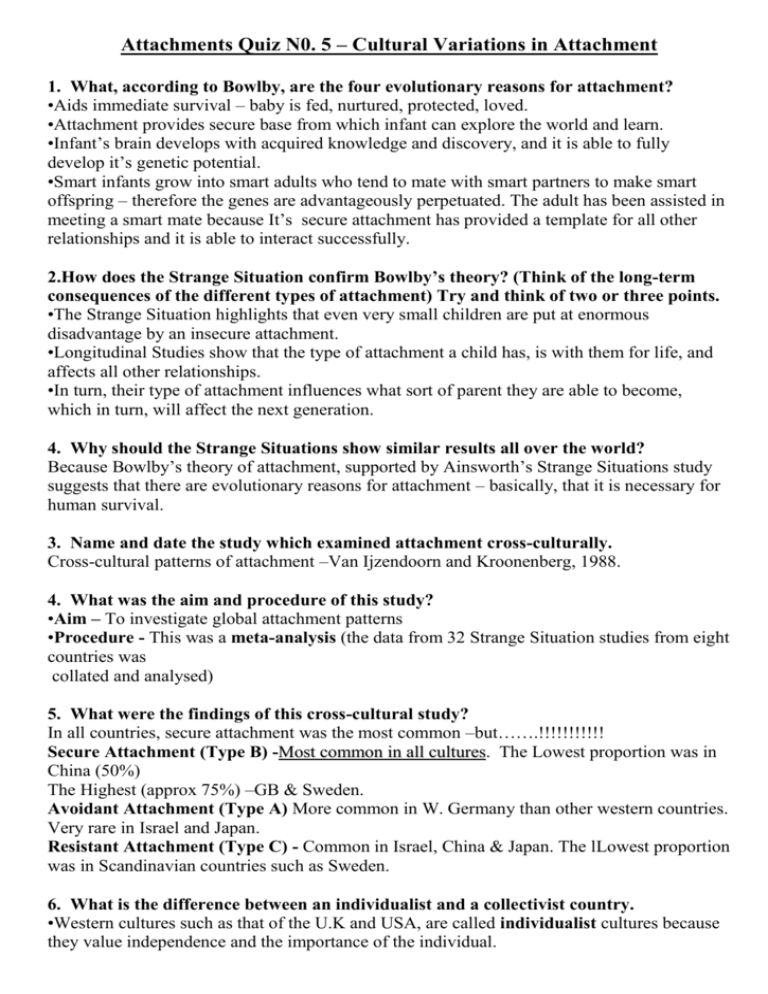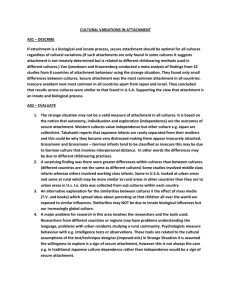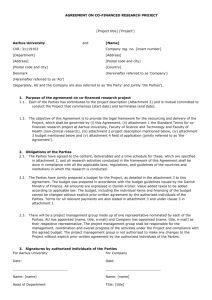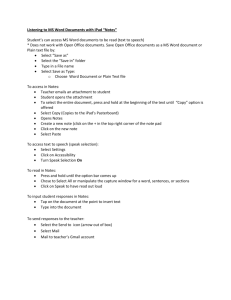Attachments Quiz N0 5 - The Grange School Blogs
advertisement

Attachments Quiz N0. 5 – Cultural Variations in Attachment 1. What, according to Bowlby, are the four evolutionary reasons for attachment? •Aids immediate survival – baby is fed, nurtured, protected, loved. •Attachment provides secure base from which infant can explore the world and learn. •Infant’s brain develops with acquired knowledge and discovery, and it is able to fully develop it’s genetic potential. •Smart infants grow into smart adults who tend to mate with smart partners to make smart offspring – therefore the genes are advantageously perpetuated. The adult has been assisted in meeting a smart mate because It’s secure attachment has provided a template for all other relationships and it is able to interact successfully. 2.How does the Strange Situation confirm Bowlby’s theory? (Think of the long-term consequences of the different types of attachment) Try and think of two or three points. •The Strange Situation highlights that even very small children are put at enormous disadvantage by an insecure attachment. •Longitudinal Studies show that the type of attachment a child has, is with them for life, and affects all other relationships. •In turn, their type of attachment influences what sort of parent they are able to become, which in turn, will affect the next generation. 4. Why should the Strange Situations show similar results all over the world? Because Bowlby’s theory of attachment, supported by Ainsworth’s Strange Situations study suggests that there are evolutionary reasons for attachment – basically, that it is necessary for human survival. 3. Name and date the study which examined attachment cross-culturally. Cross-cultural patterns of attachment –Van Ijzendoorn and Kroonenberg, 1988. 4. What was the aim and procedure of this study? •Aim – To investigate global attachment patterns •Procedure - This was a meta-analysis (the data from 32 Strange Situation studies from eight countries was collated and analysed) 5. What were the findings of this cross-cultural study? In all countries, secure attachment was the most common –but…….!!!!!!!!!!! Secure Attachment (Type B) -Most common in all cultures. The Lowest proportion was in China (50%) The Highest (approx 75%) –GB & Sweden. Avoidant Attachment (Type A) More common in W. Germany than other western countries. Very rare in Israel and Japan. Resistant Attachment (Type C) - Common in Israel, China & Japan. The lLowest proportion was in Scandinavian countries such as Sweden. 6. What is the difference between an individualist and a collectivist country. •Western cultures such as that of the U.K and USA, are called individualist cultures because they value independence and the importance of the individual. •By contrast come cultures, such as those of Japan and China are called collectivist cultures because they value sharing and interdependence and the value of the group. 7. So why can it be argued tat the Strange Situation is biased in favour of individualist countries? •The Strange Situation was developed in the U.S, an individualist country. •But in Japan for example, which is a collectivist country, the cultural norm is for mothers and babies to rarely be separated, which means we might expect to see high levels of separation anxiety and might explain the high % of Type C in the SS. Many of the differences in the cross-cultural SS concern collectivist countries. 8. Why must we be careful in interpreting data from the cross-cultural Strange Situations? Well for example, what we call “avoidant” behaviour in the UK and USA, might well be called “independent” in Germany, an individualist country, but where independence is very highly valued. And just look at the graph and you will see that there are a higher proportion of type “As” in Germany. 9. Secure attachment seems the most common attachment type world-wide. Give reasons why this may not be simply due to innate, biological reasons. Van Ijzendoom and Kroonenberg sugest that the apparent cultural similarities they found might be explained by the effects of the mass media, with TV and internet, which spreads ideas about parenting so that children all over the world are exposed to similar influences. 10. Give methodological reasons why this study could be accused of being culturally biased. •Half of the 32 studies studied were carried out in the US, reflecting the dominance of US in psychology studies. •27 were carried out in individualistic cultures •Only 5 in collectivist cultures, implying that the sample was not truly representative. 11. If you were to give a methodological “health warning” to the Cross-Cultural Strange Situation, what would it be? •Ainsworth’s Strange Situation was developed in the US so we can only make valid interpretations in cross-cultural studies if we really understand the attitudes to childrearing in that culture. 12. Given all the difficulties of interpreting the cross-cultural data would could we nevertheless conclude from this study? •Whilst there are differences, and to some extent, attachment theory is culture-bound, the impressive fact is that in in all 8 countries involved in the meta-analysis of the Strange Situation, secure attachment was the most common, by far, and we could conclude, the “best” for healthy social and emotional development.








